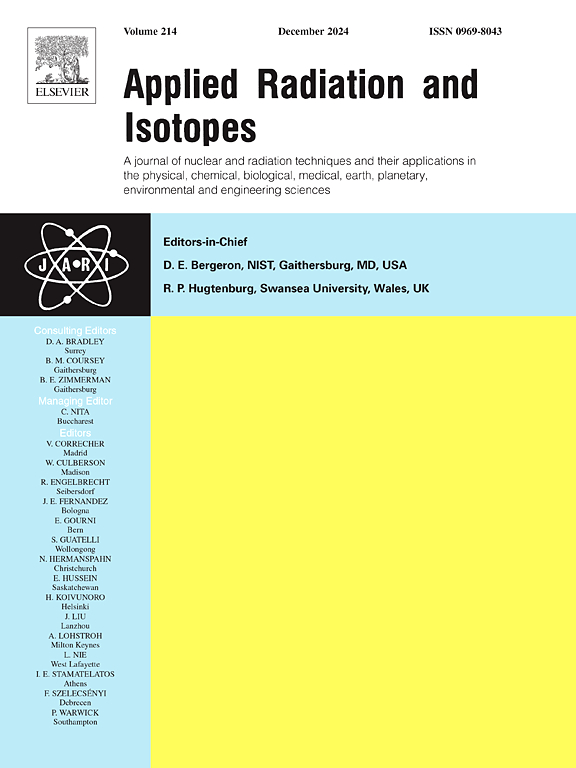A matrix effect correction method for fissile nuclear material mass measurement by delayed neutrons
IF 1.8
3区 工程技术
Q3 CHEMISTRY, INORGANIC & NUCLEAR
引用次数: 0
Abstract
Active neutron interrogation (ANI), extensively employed in nuclear safeguards, is sensitive to the presence of special nuclear materials (SNMs). However, the interaction of the matrix material with neutrons weakens the precision of fissile mass measurements by the ANI system. Therefore, it is paramount to ensure that the evaluation of the fissile mass remains unaffected by the matrix and enhances the assay performance of the ANI system. The present work proposes a matrix correction method based on the neutron flux monitor group (NFMG) response to tackle this issue. Based on the varying influence of different matrices on the neutron energies and fluxes, the NFMG response can be used to quantify the matrix effects. This allows the method to enable the identification of matrices already present in the database and has the potential to compensate for unknown matrix effects. To validate the applicability and accuracy of this method, a Shuffler system model and various matrix compositions were developed using the Geant4 toolkit. The results demonstrate that the improved simulated annealing (SA) algorithm exhibits excellent stability when confronted with varying enrichments and distributions of U3O8 materials. When the threshold is set at ≥ 0.90, the improved SA algorithm achieves a successful identification rate of 90.4% for matrices. Simultaneously, using the response equation, the average relative deviation of the corrected 235U mass is no more than 7%. For the unknown matrix, the correction capability of this method relies primarily on the construction of the reference database and the response equation. In most cases, the average relative deviation of the corrected 235U mass is less than 28%.
利用延迟中子测量裂变核材料质量的矩阵效应修正方法
核保障中广泛使用的主动中子探测(ANI)对特殊核材料(SNM)的存在十分敏感。然而,基质材料与中子的相互作用会削弱有源中子探测系统测量裂变质量的精度。因此,最重要的是确保裂变质量的评估不受基质的影响,并提高 ANI 系统的检测性能。本研究提出了一种基于中子通量监测组(NFMG)响应的基质校正方法来解决这一问题。根据不同基质对中子能量和通量的不同影响,NFMG 响应可用于量化基质效应。这使得该方法能够识别数据库中已有的基质,并有可能补偿未知的基质效应。为了验证该方法的适用性和准确性,使用 Geant4 工具包开发了一个舒普勒系统模型和各种基质成分。结果表明,改进的模拟退火(SA)算法在面对不同富集度和分布的八氧化三铀材料时表现出卓越的稳定性。当阈值设定为 α ≥ 0.90 时,改进的 SA 算法对矩阵的成功识别率达到 90.4%。同时,利用响应方程,修正后的 235U 质量的平均相对偏差不超过 7%。对于未知矩阵,该方法的修正能力主要依赖于参考数据库和响应方程的构建。在大多数情况下,修正后的 235U 质量的平均相对偏差小于 28%。
本文章由计算机程序翻译,如有差异,请以英文原文为准。
求助全文
约1分钟内获得全文
求助全文
来源期刊

Applied Radiation and Isotopes
工程技术-核科学技术
CiteScore
3.00
自引率
12.50%
发文量
406
审稿时长
13.5 months
期刊介绍:
Applied Radiation and Isotopes provides a high quality medium for the publication of substantial, original and scientific and technological papers on the development and peaceful application of nuclear, radiation and radionuclide techniques in chemistry, physics, biochemistry, biology, medicine, security, engineering and in the earth, planetary and environmental sciences, all including dosimetry. Nuclear techniques are defined in the broadest sense and both experimental and theoretical papers are welcome. They include the development and use of α- and β-particles, X-rays and γ-rays, neutrons and other nuclear particles and radiations from all sources, including radionuclides, synchrotron sources, cyclotrons and reactors and from the natural environment.
The journal aims to publish papers with significance to an international audience, containing substantial novelty and scientific impact. The Editors reserve the rights to reject, with or without external review, papers that do not meet these criteria.
Papers dealing with radiation processing, i.e., where radiation is used to bring about a biological, chemical or physical change in a material, should be directed to our sister journal Radiation Physics and Chemistry.
 求助内容:
求助内容: 应助结果提醒方式:
应助结果提醒方式:


